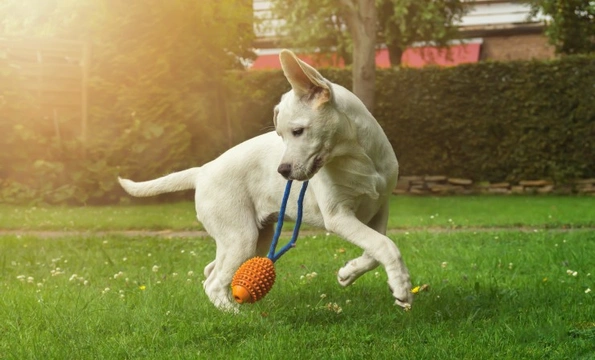
How to motivate a dog to play and exercise
Most dogs are up and running at the first mention of the word “walkies,” or often, any time you get too close to their lead or the door! Within the UK, not getting enough exercise and physical activity is a much more common issue for dogs than trying to motivate a dog to be more active – but if your dog is reluctant to play and exercise, this can be just as much of a problem!
Whether you want to keep your dog fit, help them to lose weight or simply don’t think they’re as lively and fun-loving as they should be, having a dog that seems to be naturally sedentary can be a challenge to walk and get moving. If this sounds like your dog, in this article we will share some tips and advice on how to motivate a dog to play and exercise, and what may be causing their reluctance in the first place. Read on to learn more.
Assess the situation first
Before you begin trying out new things to motivate your dog and get them moving, it is important to try to establish why your dog is a little sluggish to start with. Different dog breeds need different levels of exercise and activity, and some breeds like the Greyhound tend to be quite lazy compared to others – although all dogs still need walks and exercise!
Older dogs will also need and want less exercise than younger dogs – so if your dog is getting on in years and starting to slow down, this is natural and not something that usually requires correction. However, if your dog is in their prime and/or fit and previously very keen to exercise and play, there might be a health problem or other issue in play that leads to a reluctance to exercise, perhaps due to pain or low energy levels. Have your dog checked out by your vet just to be on the safe side, and to get some guidance on how to proceed.
A dog that is overweight will also have a lower tolerance for exercise and be less interested in playing – and whilst overweight dogs are the dogs that can most benefit from more activity, going from sedentary to boot camp overnight will not work, nor will it be enjoyable for your dog – so you should work progressively and slowly to increase their fitness levels.
Also, a dog that is underweight, or whose weight is average but whose diet is poor or does not provide enough energy will also lack the energy they need to exercise and play properly too.
How to motivate your dog
If your dog isn’t interested in playing or is reluctant to walk very far, there are a range of different approaches you can take to encouraging and motivating them, and you might have to try more than one as every dog is different!
Take your dog somewhere new
Even if you always walk your dog along the same route every day, most dogs will still be very keen to go out – but if you change things up and find somewhere new to take your dog, this will almost certainly pique their interest.
Vary your walking route and try to take in some new stimulus regularly, or perhaps take your dog out in the car to a special park, beach or run where they can experience some new sights and sounds.
Seek out other dogs
Most dogs are very sociable with others, and will be more inclined to play and run around if they have company and some other dogs to play with. Unless your dog is very reactive or nervous – which is something you should work on – going to a dog park or walking with another dog can often help to get a reluctant canine off the couch!
Use training treats and teach new skills
If you are trying to maintain your dog’s weight or help them to lose weight, treats should be measured carefully and given sparingly – otherwise you will negate all of your good work. However, dogs are highly motivated by food, and factoring a few training treats into your dog’s daily diet gives you the chance to use these treats as an incentive and reward to get your dog moving, keep their attention, and teach them new skills.
Consider teaching your dog new tricks or playing recall games, using treats as motivation.
Play with interactive toys
If your dog has a large box full of toys that they ignore, the extra push they need might simply be having someone to play with – so use balls, and other interactive toys to play with your dog one on one. Dogs thrive on attention, and will usually keep going longer if you are playing with them, rather than expecting them to entertain themselves on their own.
Turn walks into a game
When it comes to your dog’s walks, keep their walks varied and interesting and look for new things to explore. Try to find a way to turn walkies into a game, perhaps by encouraging your dog to follow scents or search out toys, and once your dog gets some intellectual stimulation in this way, the physical effort will usually follow it!



